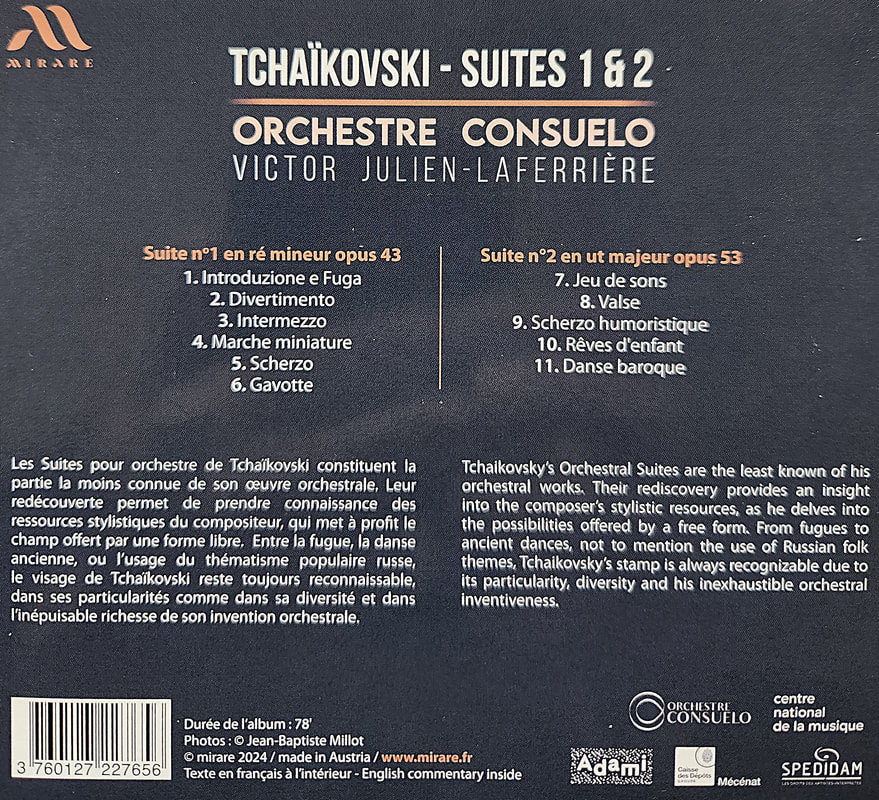Now another relative newcomer records #1 and 2 for Mirare. And I’m intrigued – for a couple of reasons.
What’s interesting is that conductors new to the recording scene are taking up Tchaikovsky’s Suites rather than his Symphonies. And that’s a very good thing. The competition is fierce in the Symphonies, and a newcomer has to be very special indeed to make any kind of impact (let alone positive impression) in such familiar repertoire. But they can have more of a chance to shine – to be distinctive and distinguished – in lesser-known works. So the Suites are a logical and intelligent place to start.
But it’s risky. These pieces are not easy to pull off. They require proficiency and a real understanding of the music, along with skill and real leadership abilities to get an orchestra to make them work.
So it’s therefore even more interesting that Russian Kochanovsky does indeed shine (at least in Tchaikovsky), while British Chauhan (a product of the Royal Northern College of Music in Manchester) does not. In fact, Chauhan reveals himself to be a rather mediocre conductor in this music (yet Chandos keeps recording more and more of it anyway, for reasons I will never understand.)
Meanwhile, Victor Julien-Laferriere, looking very young and almost innocent on the CD cover (he’s actually in his mid-30s), has tackled the first two Suites in this, his second recording with the Orchestre Consuelo, which he founded in 2021. I thought his first recording with them (Brahms Serenades) was quite amateurish and I was extremely hesitant to purchase a new CD from this group having a go at Tchaikovsky. However, after listening to Chauhan’s rather ordinary readings, I thought – well Julien-Laferriere can’t be any worse. Well, it turns out he isn’t worse. In fact, he’s much better! I am amazed at the difference between the two conductors in the one work they have both recorded (the 2nd Suite), and I’m amazed at the difference with Julien-Laferriere (“J-L”) and his young orchestra in just a year since their earlier Brahms. I’m so glad I decided to give him another chance, for this new recording is really quite wonderful.
Eager to compare the two recordings, it was with the Second Suite I began listening, and instantly, the enraptured, sweetly singing Consuelo strings make me once again love the opening movement in a way Chauhan could not. And instantly, I hear an emotional expressiveness from him which was somewhat curtailed in the earlier recording. And as the music progresses, the allegro molto vivace takes off in an engaging and positively invigorating way which Chauhan couldn’t begin to match. Moreover, there is a rhythmic security to the playing which increases dramatic involvement and sheer excitement in the musicmaking. J-L exhibits a distinct sense of purpose which was curiously missing from Chauhan.
To be fair, the Consuelo strings are not as rich or sumptuous as the BBC Scottish Symphony Orchestra’s (and I’m sure they are fewer in numbers, as I believe this is technically a chamber orchestra-sized group.) And the acoustic in which they play is just a touch dry compared to the luxurious one in Glasgow. But there is a warmth to Mirare’s recorded sound here which is an improvement over their Brahms. And taken on its own, this is entirely satisfactory, and quite pleasing, recorded sound. So we’re off to a great start.
The Valse is delightfully lilting and imbued with charm in J-L’s hands. It’s involving too, with a propulsive sense of direction, revealing this to be yet another wonderful Tchaikovsky waltz. It is followed by the infamous Scherzo Burlesque which is very exciting here. Unlike Chandos, which ridiculously spotlights the accordions to the front of the orchestra with a concerto-like presence, Mirare keeps them back in the midst of the orchestra where they belong. And their contribution is simply an amusing, and decidedly unusual, new color coming from within the orchestra – wheezing away to-and-fro between their two assigned chords. All the while, the orchestra (marked fff) whips itself into a frenzy, just as it should. And without the unnecessary, contrived emphasis on the novelty of it (as portrayed on Chandos), the music itself becomes positively thrilling! And J-L doesn’t hold back either; he encourages his orchestra to have a real go at it. And it’s simply brimming with vigor and adrenaline. This is a conductor with a real vision. What a difference from the one on Chandos!
After that, the dreamy slow movement can’t help but be a bit of a letdown; however J-L doesn’t just let it wither like Chauhan does. He still has a real feel for it – again displaying a naturally flowing, rhapsodic elasticity to the tempo and emotional expressiveness, while his strings continue to sing ever so sweetly, keeping us thoroughly engaged. The final Danse baroque then is light and fleet, taken at a cracking tempo. While it may not be quite as dramatically exciting as Chauhan (who finally found something he liked), it fits better within the overall conception and scope of the piece in a way which had never even occurred to Chauhan. And with its appropriately lighter touch (it is a baroque dance, after all), it is whisked away like a whirlwind, fast and ebullient, brilliantly played by this fine orchestra. It is as exhilarating as you’ll ever hear it.
I’m so happy this recording makes me love this piece again. Chauhan left me feeling like it was a somewhat weak composition. But J-L confirms what I already knew to be true: that certainly wasn’t Tchaikovsky’s fault.
Now to the First Suite, where I can forget all about comparisons and concentrate solely on Mr. Julien-Laferriere. And if anything, it’s even better. The plaintive bassoon and shimmering strings in the opening set the tone, creating an atmosphere uniquely Tchaikovsky. While the Fuga is energetic, dramatic and purposeful (with gloriously soaring horns) without ever sounding grandiose. J-L again demonstrates a true conception of the overall scope of the piece. The Divertimento waltz is glittering and balletic, alternating with dramatic outbursts, reminding one of Tchaikovsky’s very best ballet music. The Intermezzo (andantino semplice) starts simply, as it should, but J-L soon enriches the lines with a touch of rapturous passion. Aching beautiful melodies permeate this section, and over and over, J-L reveals this entire piece to be one of Tchaikovsky’s most glorious creations. (And once again I marvel that this is the same conductor that so disappointed in Brahms.)
To more familiar territory we go with the Marche Miniature, and it is as delightful as ever in J-L’s hands – though he reminds us it’s a “miniature” and is marked moderato; it’s not taken too fast and thus emerges with intrinsic charm. The Scherzo then is light and animated, and amusingly, J-L brings out its strong resemblance to the burlesque to come in the Second Suite. (In fact, I kept expecting accordions to come bounding in here – Ha!) The final Gavotte is playful enough, but informed with a bit of gravitas too, in keeping with the overall scope and temperament of the work. And with it, J-L has expertly shaped the entire piece into a masterly, cohesive whole, making one wonder why this masterpiece isn’t performed (or recorded) more often.
This reading of the First Suite is surely the most successful I can ever remember hearing (though it’s been a long time since I’ve listened to one). And the recording is slightly more alluring than in the companion on the CD – just a touch warmer and more atmospheric. The booklet tells us the two Suites were recorded at different sessions, separated by 9 months, which might account for the subtle difference.
So with this recording of the 1st and 2nd, and Kochanovsky’s 3rd on harmonia mundi, I can completely forget all about Chauhan (and I wish Chandos would too) and whatever he does with the remaining Suites. I’ll just patiently wait for one of these better conductors to do the 4th and I’ll be happy having a complete, well recorded, modern set.










